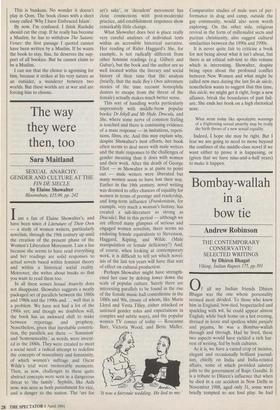Bombay-wallah in a bow tie
Andrew Robinson
THE CONTEMPORARY CONSERVATIVE: SELECTED WRITINGS by Dhiren Bhagat Viking, Indian Rupees 175, pp.391 0 f all my Indian friends Dhiren Bhagat was the one whose personality seemed most divided. To those who knew him in England, bow-tied, bespectacled and sparkling with wit, he could appear almost English; while back home on a hot evening, dressed in loose and spotless white panjabi and pyjama, he was a Bombay-wallah through and through. Had he lived, these two aspects would have yielded a rich har- vest of writing, fed by both cultures.
As it is, we have a varied crop of incisive, elegant and occasionally brilliant journal- ism, chiefly on India and India-related affairs, some of which provided salutary jolts to the government of Rajiv Gandhi. It is a tribute to Dhiren's influence that when he died in a car accident in New Delhi in November 1988, aged only 31, some were briefly tempted to see foul play: he had only recently exposed a murky deal involv- ing arms imported by RAW, the Indian secret service, allegedly for use in the Punjab.
That troubled area, the home of Dhiren's family until 1947, was the subject of the first of his many pieces for The Spectator, and I am happy to say that I effected the introduction. Dhiren and I were lunching in Covent Garden — he, no doubt, eating vegetarian food sans alcohol, coffee or tobacco — when I happened to see Charles Moore in the restaurant. The Golden Temple had just been stormed by the Indian Army: within minutes Dhiren had placed an article on the damage and the legend of Bhindranwale's surviving the attack.
By that time, mid-1984, Dhiren had already written extensively for the Indian press after coming down from Oxford three years previously. He was fortunate to have arrived home at the launch of India's first Sunday paper, Bombay's Sunday Observer, and to find in Vinod Mehta a shrewd and sympathetic editor.
To most people, Dhiren was not immediately endearing [writes Mehta, in an affectionate but notably balanced introduction].They thought he was affected, snobbish, and pre- tentious. Most of all, they thought he was yet another Oxford-returned, spoiled, young brat out to sensationalise and shock his way into centre-stage.
In fact, Dhiren was simply intolerant of mediocrity and hypocrisy, and with his insider's knowledge of Indian society and his Oxford-trained eye, could seldom resist the urge to puncture politicians, pundits and artists. This, allied to a sense of history and impressive thoroughness of research, was bound to excite attention.
All his qualities and his streak of mis- chief are evident in the piece he wrote in early 1984, 'Is the Film Biased?' Its subject, Granada Television's documentary about Subhas Chandra Bose, leader of the Indian National Army under the Japanese, was perfect for Dhiren. He took to it with glee and diligence in checking facts. Here was a chance to reveal feet of clay on an Indian sacred cow, better still a Bengali one, while chiding the British for insufficient serious- ness. As a then-employee of Granada, a company not averse to controversy, I assist- ed with a private viewing of the film.
In the article he wrote for India's Illustrated Weekly, Dhiren systematically dismantled the published criticism which had led to the film's banning in India, enjoying some special fun with the com- ment that the film labelled Bose a 'clown in jackboots among other epaulettes'. Obviously, said Dhiren, the printer's devil had substituted 'epaulettes' for 'epithets' but, much more importantly, the film made no such charge about Bose: which indeed it did not. (The view was basically Gandhi's.) Nevertheless, the film's tone was 'flip', con- cluded Dhiren fairly; it treated Bose as essentially insubstantial rather than as a hero — a difference of perspective that lies at the heart of much British writing on India.
If he could be trenchant about Indian nationalist myths, Dhiren could amusingly dissect lingering colonial ones too. Indian matrimonial columns, for instance, which are always good for a foreign giggle. Actually, Dhiren pointed out, these adver- tisements are 'a part of the imperial legacy, like railway engines, parliament, and postage stamps': he then proceeded to prove it with sone juicy 18th- and 19th- century examples from British news- papers, and add the pithy comment that this sort of advertising is no more respectable in India today than it once was in Britain.
Such awareness of tradition in both civili- sations, and of its correct interpretation, gave Dhiren's work its flavour and percipi- ence. It also gave him a distrust of received liberal wisdom in government and intellec- tual circles that is largely justified by events in recent decades. ICharab baaten kyoon sikhayen? — Why should we teach bad things?', a Muslim leader asks of an attempt at history teaching that includes the destruction of Hindu temples and forced conversions to Islam. 'You must delete all references to Gandhiji . . . he's a controversial figure,' a government official insists. 'In many ways', writes Dhiren with regret, 'that is the official line that secular India takes on history, and there can be only one casualty as a result: the truth.' At the time of his death he was writing a book on his roots in Punjab, having moved from Bombay to a small cottage in the hill- station founded by the British at Mussoorie. There, among the woods he loved as a small boy, something recalled by his mother in a calm and beautiful postscript, Dhiren returned to poetry, his first love. Here is his last, extraordinarily English poem: The Shanty Autumn. How browned ferns stick to the lichen, disguise each tree. How trees, grown past imagining, tangle, hide the house, enclose me.
Morning here, the first thing I did, junked the curtains. Today fighting fern and tangle I smash the panes, let the rising mist fill the front room.



















































 Previous page
Previous page